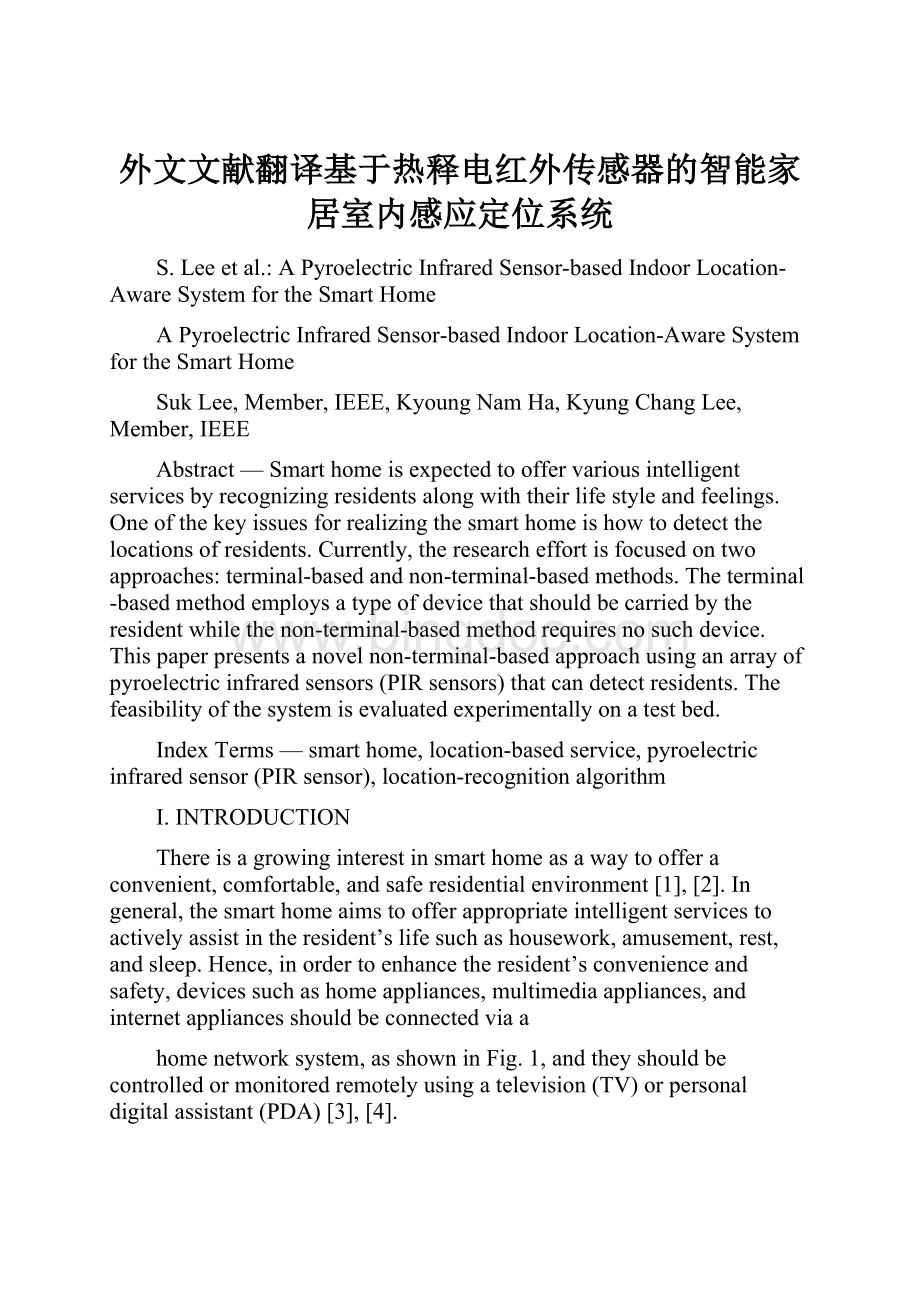外文文献翻译基于热释电红外传感器的智能家居室内感应定位系统文档格式.docx
《外文文献翻译基于热释电红外传感器的智能家居室内感应定位系统文档格式.docx》由会员分享,可在线阅读,更多相关《外文文献翻译基于热释电红外传感器的智能家居室内感应定位系统文档格式.docx(24页珍藏版)》请在冰点文库上搜索。

APyroelectricInfraredSensor-basedIndoorLocation-AwareSystemfortheSmartHome
SukLee,Member,IEEE,KyoungNamHa,KyungChangLee,Member,IEEE
Abstract—Smarthomeisexpectedtooffervariousintelligentservicesbyrecognizingresidentsalongwiththeirlifestyleandfeelings.Oneofthekeyissuesforrealizingthesmarthomeishowtodetectthelocationsofresidents.Currently,theresearcheffortisfocusedontwoapproaches:
terminal-basedandnon-terminal-basedmethods.Theterminal-basedmethodemploysatypeofdevicethatshouldbecarriedbytheresidentwhilethenon-terminal-basedmethodrequiresnosuchdevice.Thispaperpresentsanovelnon-terminal-basedapproachusinganarrayofpyroelectricinfraredsensors(PIRsensors)thatcandetectresidents.Thefeasibilityofthesystemisevaluatedexperimentallyonatestbed.
IndexTerms—smarthome,location-basedservice,pyroelectricinfraredsensor(PIRsensor),location-recognitionalgorithm
I.INTRODUCTION
Thereisagrowinginterestinsmarthomeasawaytoofferaconvenient,comfortable,andsaferesidentialenvironment[1],[2].Ingeneral,thesmarthomeaimstoofferappropriateintelligentservicestoactivelyassistintheresident’slifesuchashousework,amusement,rest,andsleep.Hence,inordertoenhancetheresident’sconvenienceandsafety,devicessuchashomeappliances,multimediaappliances,andinternetappliancesshouldbeconnectedviaa
homenetworksystem,asshowninFig.1,andtheyshouldbecontrolledormonitoredremotelyusingatelevision(TV)orpersonaldigitalassistant(PDA)[3],[4].
Fig.1.Architectureofthehomenetworksystemforsmarthome
Especially,attentionhasbeenfocusedonlocation-basedservicesasawaytoofferhigh-qualityintelligentservices,whileconsideringhumanfactorssuchaspatternofliving,health,andfeelingsofaresident[5]-[7].Thatis,ifthesmarthomecanrecognizetheresident’spatternoflivingorhealth,thenhomeappliancesshouldbeabletoanticipatetheresident’sneedsandofferappropriateintelligentservicemoreactively.Forexample,inapassiveserviceenvironment,theresidentcontrolstheoperationoftheHVAC(heating,ventilating,andairconditioning)system,whilethesmarthomewouldcontrolthetemperatureandhumidityofaroomaccordingtotheresident’scondition.Variousindoorlocation-awaresystemshavebeendevelopedtorecognizetheresident’slocationinthesmarthomeorsmartoffice.Ingeneral,indoorlocation-awaresystemshavebeenclassifiedintothreetypesaccordingtothemeasurementtechnology:
triangulation,sceneanalysis,andproximitymethods[8].Thetriangulationmethodusesmultipledistancesfrommultipleknownpoints.ExamplesincludeActiveBadges[9],ActiveBats[10],andEasyLiving[11],whichuseinfraredsensors,ultrasonicsensors,andvisionsensors,respectively.Thesceneanalysismethodexaminesaviewfromaparticularvantagepoint.RepresentativeexamplesofthesceneanalysismethodareMotionStar[12],whichusesaDCmagnetictracker,andRADAR[13],whichusesIEEE802.11wirelesslocalareanetwork(LAN).Finally,theproximitymethodmeasuresnearnesstoaknownsetofpoints.AnexampleoftheproximitymethodisSmartFloor[14],whichusespressuresensors.
Alternatively,indoorlocation-awaresystemscanbeclassifiedaccordingtotheneedforaterminalthatshouldbecarriedbytheresident.Terminal-basedmethods,suchasActiveBats,donotrecognizetheresident’slocationdirectly,butperceivethelocationofadevicecarriedbytheresident,suchasaninfraredtransceiverorradiofrequencyidentification(RFID)tag.Therefore,itisimpossibletorecognizetheresident’slocationifheorsheisnotcarryingthedevice.Incontrast,non-terminalmethodssuchasEasyLivingandSmartFloorcanfindtheresident’slocationwithoutsuchdevices.However,EasyLivingcanberegardedtoinvadetheresident’sprivacywhiletheSmartFloorhasdifficultywithextendibilityandmaintenance.
Thispaperpresentsanon-terminalbasedlocation-awaresystemthatusesanarrayofpyroelectricinfrared(PIR)sensors[15],[16].ThePIRsensorsontheceilingdetectthepresenceofaresidentandarelaidoutsothatdetectionareasofadjacentsensorsoverlap.BycombiningtheoutputsofmultiplePIRsensors,thesystemisabletolocatearesidentwithareasonabledegreeofaccuracy.Thissystemhasinherentadvantageofnon-terminalbasedmethodswhile
avoidingprivacyandextendibility,maintenanceissues.Inordertodemonstrateitsefficacy,anexperimentaltestbedhasbeenconstructed,andtheproposedsystemhasbeenevaluatedexperimentallyundervariousexperimentalconditions.Thispaperisorganizedintofoursections,includingthisintroduction.SectionIIpresentsthearchitectureofthePIRsensor-basedindoorlocation-awaresystem(PILAS),andthelocation-recognitionalgorithm.SectionIIIdescribesaresident-detectionmethodusingPIRsensors,andevaluatestheperformanceofthesystemundervariousconditionsusinganexperimentaltestbed.Finally,asummaryandthe
conclusionsarepresentedinSectionIV.
II.ARCHITECTUREOFTHEPIRSENSOR-BASEDINDOOR
LOCATION-AWARESYSTEM
A.Frameworkofthesmarthome
Giventheindoorenvironmentofthesmarthome,anindoorlocation-awaresystemmustsatisfythefollowingrequirements.First,thelocation-awaresystemshouldbeimplementedata
relativelylowcostbecausemanysensorshavetobeinstalledinroomsofdifferentsizestodetecttheresidentinthesmarthome.Second,sensorinstallationmustbeflexiblebecausetheshapeofeachroomisdifferentandthereareobstaclessuchashomeappliancesandfurniture,whichpreventthenormaloperationofsensors.Thethirdrequirementisthatthesensorsforthelocation-awaresystemhavetoberobusttonoise,andshouldnotbeaffectedbytheirsurroundings.ThisisbecausethesmarthomecanmakeuseofvariouswirelesscommunicationmethodssuchaswirelessLANorradio-frequency(RF)systems,whichproduceelectromagneticnoise,ortheremaybesignificantchangesinlightortemperaturethatcanaffectsensorperformance.Finally,itisdesirablethatthesystem’saccuracyisadjustableaccordingtoroomtypes.
Amongmanysystemsthatsatisfytherequirement,thePIRsensor-basedsystemhasnotattractedmuchattentioneventhoughthesystemhasseveraladvantages.ThePIRsensors,whichhavebeenusedtoturnonalightwhenitdetectshumanmovement,arelessexpensivethanmanyothersensors.Inaddition,becausePIRsensorsdetecttheinfraredwavelengthemittedfromhumansbetween9.4~10.4μm,theyarereasonablyrobusttotheirsurroundings,intermsoftemperature,humidity,andelectromagneticnoise.Moreover,itispossibletocontrolthelocationaccuracyofthesystembyadjustingthesensingradiusofaPIRsensor,andPIRsensorsareeasilyinstalledontheceiling,wheretheyarenotaffectedbythestructureofaroomoranyobstacles.
Figure2showstheframeworkforthePILASinasmarthomethatofferslocation-basedintelligentservicestoaresident.Withinthisframework,variousdevicesareconnectedviaahomenetworksystem,includingPIRsensors,roomterminals,asmarthomeserver,andhomeappliances.Here,eachroomisregardedasacell,andtheappropriatenumberofPIRsensorsisinstalledontheceilingofeachcelltoprovidesufficientlocationaccuracyforthelocation-basedservices.EachPIRsensorattemptstodetecttheresidentataconstantperiod,andtransmitsitssensinginformationtoaroomterminalviathehomenetworksystem.
Fig.2.FrameworkofsmarthomeforthePILAS.
Consequently,theroomterminalrecognizestheresident’slocationbyintegratingthesensorinformationreceivedfromallofthesensorsbelongingtoonecell,andtransmitstheresident’slocationtothesmarthomeserverthatcontrolsthehomeappliancestoofferlocation-basedintelligentservicestotheresident.
Withinthisframework,thesmarthomeserverhasthefollowingfunctions.1)Thevirtualmapgeneratormakesavirtualmapofthesmarthome(generatingavirtualmap),andwritesthelocationinformationoftheresident,whichisreceivedfromaroomterminal,onthevirtualmap(writingtheresident’slocation).Then,itmakesamovingtrajectoryoftheresidentbyconnectingthesuccessivelocationsoftheresident(trackingtheresident’smovement).2)Thehomeappliancecontrollertransmitscontrolcommandstohomeappliancesviathehomenetworksystemtoprovideintelligentservicestotheresident.3)Themovingpatternpredictorsavesthecurrentmovementtrajectoryoftheresident,thecurrentactionofhomeappliances,andparametersreflectingthecurrenthomeenvironmentsuchasthetime,temperature,humidity,andillumination.Afterstoringsufficientinformation,itmaybepossibletoofferhuman-orientedintelligentservicesinwhichthehomeappliancesspontaneouslyprovideservicestosatisfyhumanneeds.Forexample,ifthesmarthomeserver“knows”thattheresidentnormallywakesupat7:
00A.M.andtakesashower,itmaybepossibletoturnonthelampsandsomemusic.Inaddition,thetemperatureoftheshowerwatercanbesetautomaticallyfortheresident.
B.Location-recognitionalgorithm
Inordertodeterminethelocationofaresidentwithinaroom,anarrayofPIRsensorsareusedasshowninFig.3.Inthefigure,thesensingareaofeachPIRsensorisshownasacircle,andthesensingareasoftwoormoresensorsoverlap.Consequently,whenaresidententersoneofthesensingareas,thesystemdecideswhetherhe/shebelongstoanysens